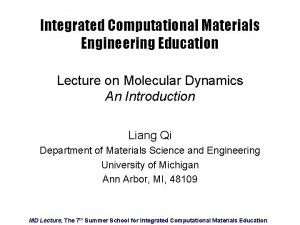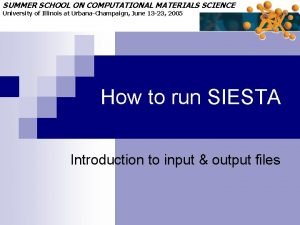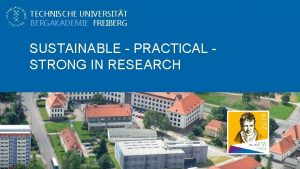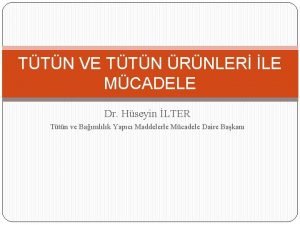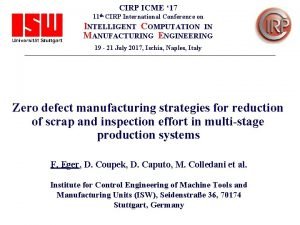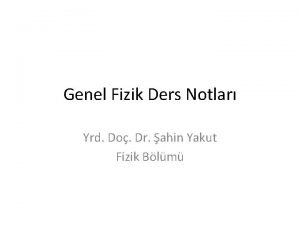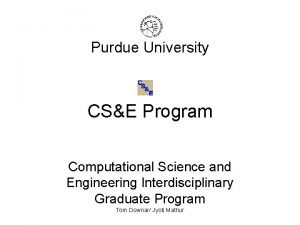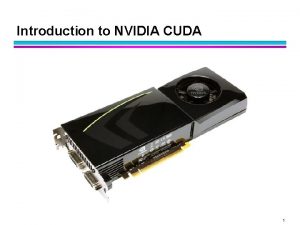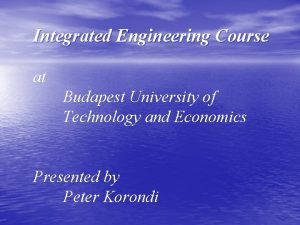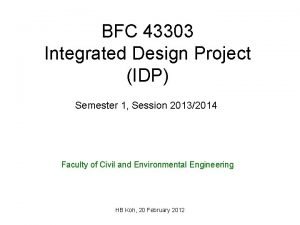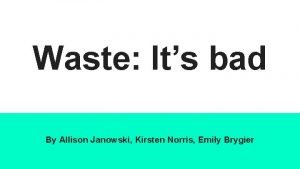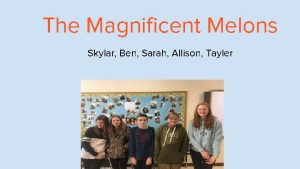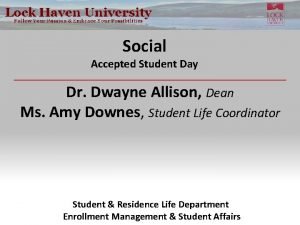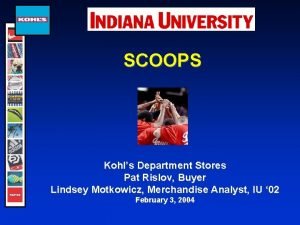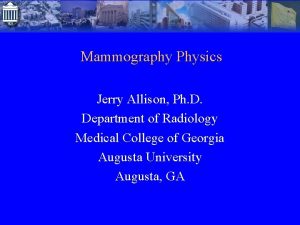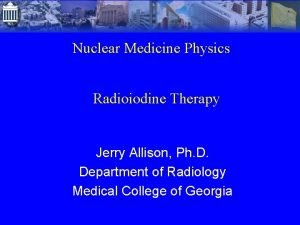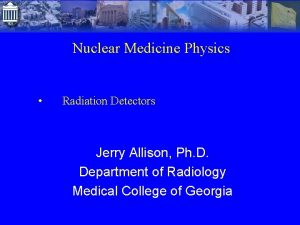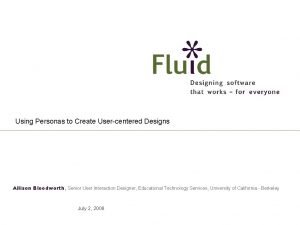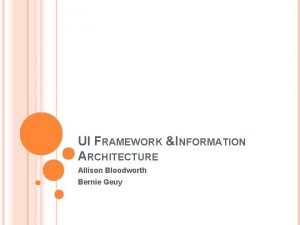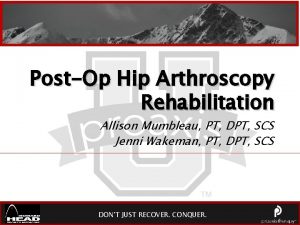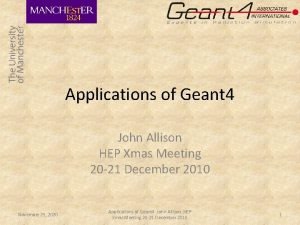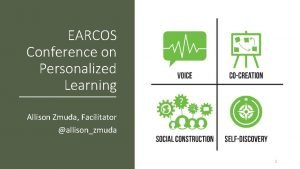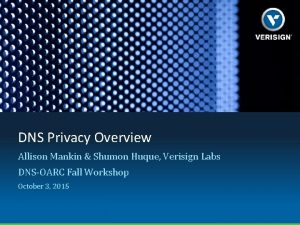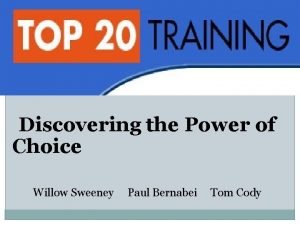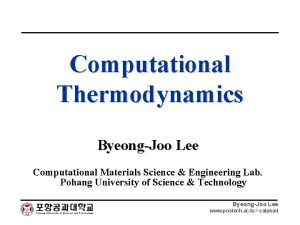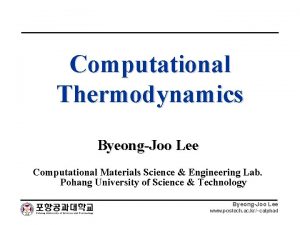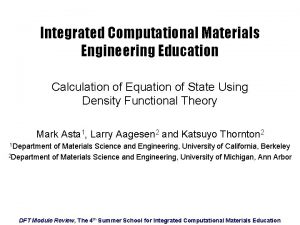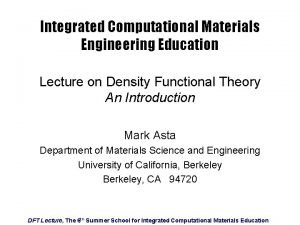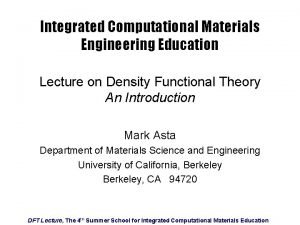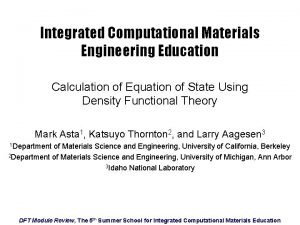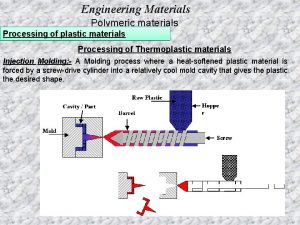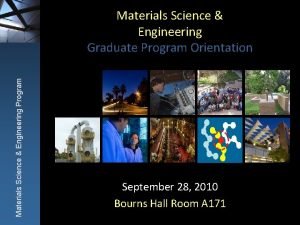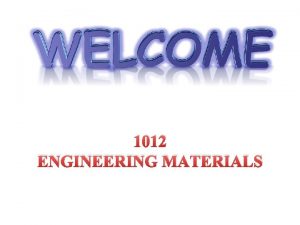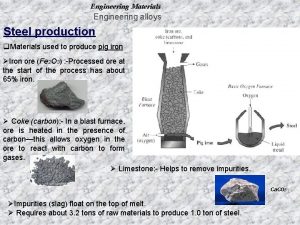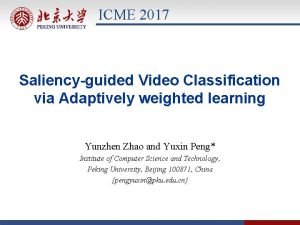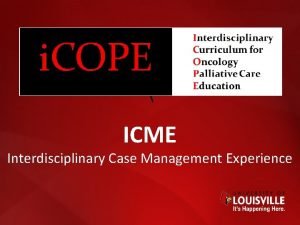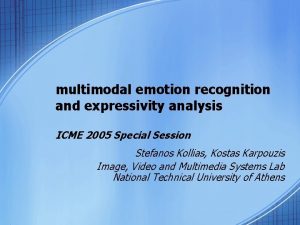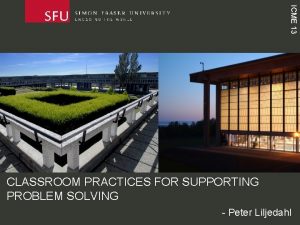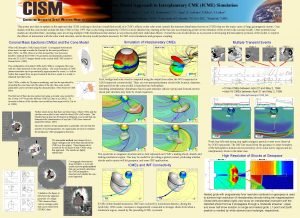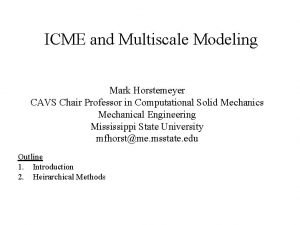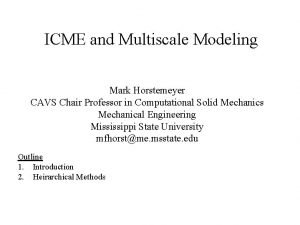Integrated Computational Materials Engineering ICME John Allison University




































































- Slides: 68

Integrated Computational Materials Engineering (ICME) John Allison University of Michigan Summer School for Integrated Computational Materials Education 2016

It takes 10 -20 years to develop a new material Societal and global competitiveness requires us to do this faster and cheaper! 250 Al-4 Cu-0. 05 Sn Al-4 Cu-0. 3 Mg-0. 5 Si Al-4 Cu-0. 3 Mg-0. 4 Ag-1 Li 200°C Hardness (VHN) 200 1989 150 100 1906 50 0 Courtesy of J. F. Nie 1 10 Ageing Time (h) 100

Outline • Integrated Computational Materials Engineering (ICME) – What it is and why it’s important • Virtual Aluminum Castings – An ICME Case Study at Ford • ICME – The Next Big Thing in Structural Materials and An Essential Element of MGI • Thoughts on ICME for Integrated Computational Materials Education (ICME for ICME)

Materials Genome Initiative . . . This initiative offers a unique opportunity for the United States to discover, develop, manufacture, and deploy advanced materials at least twice as fast as possible today, at a fraction of the cost. President Barack Obama, 24 June 2011 Announcing the Materials Genome Initiative “(In this context) genome connotes a fundamental building block toward a larger purpose” NSTC MGI White Paper, 2011

Materials Genome Initiative • Coordinated Multi-agency effort – DOE, DOD, NSF, NIST with White House OSTP leadership • $100 M / year in FY 12, FY 13 & FY 15: “ 10 year program” • Essential ingredients • Collaboration • Integration of theory, simulation and experiments • Information Infrastructure • Workforce development • ICME

A Well-Equipped Workforce (Excerpt from 6/2014 MGI Strategic Plan) - … the next generation of materials scientists and engineers must be able to expertly use these tools to achieve the success promised by MGI…. -. . before the future generation workforce can be equipped to take advantage of the Materials Innovation Infrastructure, instructors must first be provided information on these new tools, research approaches, and their value.

US National Materials Advisory Board Committee on Integrated Computational Materials Engineering (ICME) Tresa Pollock, Chair John Allison, Vice Chair 2008

Integrated Computational Materials Engineering The Vision Computationally-driven materials development is a core activity of materials professionals in the upcoming decades, uniting materials science with materials engineering and integrating materials more holistically and computationally with product development. 8

What is ICME? Integrated Computational Materials Engineering (ICME) is the integration of materials information, captured in computational tools, with engineering product performance analysis and manufacturing-process simulation. * Chemistry Thermodynamics Diffusion Manufacturing Process Simulation Quantitative Processing. Structure Relations * NAE ICME Report, 2008 Quantitative Structure. Property Relations Constitutive Models Engineering Product Performance Analysis • Process & product optimization • Innovation

What is ICME? Integrated Computational Materials Engineering (ICME) is the integration of materials information, captured in computational tools, with engineering product performance analysis and manufacturing-process simulation. * Manufacturing Process Simulation Microstructure Distribution Property Distribution Product Performance Analysis • Process & product optimization • Innovation * NAE ICME Report, 2008

Integrated Computational Materials Engineering Using advanced computational techniques, designs can be studied and optimized in matters of hours or days. Optimization of new materials must be done experimentally and can take 10 -20 years. Shape optimization of hypersonic vehicles Source: K. Bowcutt, Boeing

Why this is important • Innovations in materials and tight coupling of component design, materials and manufacturing have been key sources of industrial competitiveness • These innovations and tight coupling are threatened by advances in computational capability in design and manufacturing that have “left materials field in the dust”. • The global economy requires efficient engineering, manufacturing and R&D

The Divide Separating Materials Science and Materials Engineering Integrated Computational Materials Engineering Predicted Volume Change Quantum Mechanics Theory g Calculated Phase Diagram Kinetics Experiment Thermal Growth

Integrated Computational Materials Engineering provides a means to link: • Science and Engineering • Manufacturing, Materials and Design • Experiments, Theory, Simulation • Information Across Disciplines 8

Ford Virtual Aluminum Castings

Traditional Durability Analysis ABAQUS Load Inputs Initial Geometry Durable Component Predict Service Life Y N Database of Material Properties

Traditional Durability & Manufacturing Analysis Magma. SOFT/ Pro. Cast ABAQUS Load Inputs Initial Geometry Durable Component Predict Service Life Y N Database of Material Properties Model Casting Ensure Castability Y N

Traditional Product Development Process Pro. CAST/Magma. SOFT ABAQUS Load Inputs Initial Geometry Durable Component Predict Service Life Y N Database of Material Properties Model Casting Ensure Castability Y N Build, Test, Re-Build, Re-Test

Rearrange the Production Simulations Magma. SOFT/ Pro. CAST ABAQUS Product and Process Product Property Requirements Initial Geometry Predict Residual Stress Model Casting and Heat Treatment Ensure Castability Y N Alloy Composition Predict Local Microstructure Load Inputs Optimized Process & Product Meet Property Requirements Predict Local Properties Y N Predict Service Life Y N Optimized Component

Virtual Aluminum Castings The Ford Experiment in ICME Magma. SOFT / Pro. CAST ABAQUS Product and Process Product Property Requirements Initial Geometry Predict Residual Stress Model Casting and Heat Treatment Ensure Castability Y N Alloy Composition Predict Local Microstructure Load Inputs Optimized Process & Product Meet Property Requirements Predict Local Properties Y N Predict Service Life Y N Optimized Component

Cast Aluminum Processing-Structure-Property Linkages Heat Treatment Processing Casting Solution n Treatment Chemistry Aging Thermodynamics/ Kiinetics Microstructure Micro porosity Eutectic Phases Precipitation Materials Engineering is all about compromises – ICME provides a means to conduct quantitative tradeoffs Properties High Cycle Fatigue Low Cycle Fatigue Yield Strength Thermal Growth

Key metallurgical processes occur at many length scales – and all can be influenced by manufacturing history 1 m Engine Block 1 – 10 mm Macrostructure • Grains • Macroporosity Properties • High cycle fatigue • Ductility 10 – 500 um Microstructure • Eutectic Phases • Dendrites • Microporosity • Intermetallics Properties • Yield strength • Tensile strength • High cycle fatigue • Low cycle fatigue • Thermal Growth • Ductility 1 -100 nm Nanostructure • Precipitates Properties • Yield strength • Thermal Growth • Tensile strength • Low cycle fatigue • Ductility 0. 1 -1 nm Atomic Structure • Crystal Structure • Interface Structure Properties • Thermal Growth • Yield Strength

Microstructural Constituents in Alloy 319 • Aluminum Dendrites • Eutectic Silicon • Intermetallics – Al 2 Cu – Al 15(Fe, Mn)3 Si • Porosity Q q’

Physics Based Models – Yield Strength Yield strength (s. Y) is the sum of an intrinsic strength (si), a precipitation hardening strength (sppt), and a solid solution strength (sss): Zhu & Starke, 1999 f = volume fraction of theta’ d = diameter of theta’ platelet w= thickness of theta’ platelet

First-Principles Modification of Al-Cu Phase Diagram Incorporating Metastable q’-phase Metastable states just as easy to calculate as stable states Temperature, o. C Liquid (Al) q-phase q’-phase Al Mole Fraction Cu

VAC models capture experimental understanding where robust physics-based models are not available TEM Characterization of Precipitate Morphology vs Aging Time (319 Al alloy with 3, 3. 5 and 4%Cu)

Aging Response of 319 Aluminum Prediction vs. Experimental

Extending VAC using advanced Computational Materials Science tools. • Reduce need for costly and time consuming experiments • Alloy design Crystal Structure Metastable Precipitate Phase Equilibria Microstructure DH, DS of metastabl e phases Mechanical Properties (Yield Strength) Interfacial + strain energies + Mobilities g First. Principles Calculations Precipitate Morphologie s Bulk (SS + Precipitate) Free Energies CALPHAD Phase. Field Micromechanic al Models

First-Principles / Phase-Field Microstructural Evolution Model Al 2 Cu q' in Al Phase Field Simulation (All energetics taken from first-principles calculations) TEM Micrograph of W 319

Virtual Aluminum Castings Process Flow Local Yield Strength Prediction Initial Geometry Filling Thermal Analysis • CAD Geometry and Mesh • Accurate filling Profile (Opt. Cast) • Boundary Conditions (OPTCAST) • Fraction solid Curves (Thermo. CALC) Yield Strength • Aging Model (Thermo. CALC) Microstructure (Al 2 Cu) • Micromodel (Thermo. CALC) • Empirical Kinetics (OPTCAST)

Model Validation & Accuracy Normal Production Region

Using Virtual Aluminum Castings in Product and Process Optimization Target Strength = 220 MPa 210 230 Aging at 250 C for 3 hrs 220 Aging temperature 240 C for 5 hrs Initial Heat Treatment Process 205 Optimized Heat Treatment Process Faster and Stronger !!

Local Fatigue Strength Prediction Initial Geometry Filling Analysis Thermal Analysis Local Porosity Local Fatigue Strength

Prediction of Local Fatigue Strength Pore Size (Microns) Micro Porosity 200 Microns 1200 Microns 500 Microns Fatigue Strength 80+ MPa 56 MPa 67 MPa

Use of Local Fatigue Property Prediction for Process Development Combustion Surface 56 MPa Low Pressure Casting 84 MPa Gravity Casting

Virtual Aluminum Castings Linking Manufacturing, Materials and Design Local Residual Stresses Component Durability Local Fatigue Properties

Virtual Aluminum Castings (VAC) Pro. CAST/Magma. SOFT ABAQUS Product and Process Product Property Requirements Initial Geometry Predict Residual Stress Model Casting and Heat Treatment Ensure Castability Y N Alloy Composition Predict Local Microstructure Load Inputs Optimized Process & Product Meet Property Requirements Predict Local Properties Y N Predict Service Life Y N Optimized Component

Ford VAC R&D Team Ford R&A VAC Team Former Team Members – John Allison –Mei Li – Ruijie Zhang –Xu. Ming Su –Nagendra Palle –Larry Godlewski –Chris Wolverton (NW) –Carlos Engler – Bill Donlon –Bob Frisch – Ravi Vijayraghavan –Joy Hines Forsmark – Don Siegel (Uof. M) –John Lasecki –Jake Zindel –Eben Prabhu –Richard Chen

Ford VAC - University Partners • University of Michigan – Prof. Wayne Jones – Aging models of Aluminum Alloys – Porosity-fatigue models for 319 Al – Ultrasonic fatigue (NSF) • Imperial College –Prof. Peter Lee – Microporosity modeling • Tsinghua University – Prof. Baicheng Liu • Modeling HPDC processes • Pennsylvania State University – Prof. L. Chen – Modeling microstructural evolution (NSF) • University of Wisconsin – Prof. A. Chang – Thermodynamics Models for Cast Al & Mg (SBIR) • Ohio State University – Prof. S. Ghosh – Modeling Ductility in Cast Al (NSF) • University of Illinois – Prof. H. Sehitoglu/ J. Dantzig – Modeling Thermal-Mechanical Fatigue of Cast Aluminum – Prediction of residual stresses/quench cracking in Cast Aluminum – Optimization Methodologies

VAC Modeling Methods • Ab Initio / First Principles Theory (VASP etal) • Phase Field Models • Thermodynamic Equilibria & Diffusion (Thermo. Calc, Pandat & Dictra) • Phenomenological micromodels for microstructural evolution & mechanical properties • Continuum mechanics models – Micromechanics – Constituitive models (State Variable and Classical Plasticity) – Crystal Plasticity (FEM) • Optimization Techniques (DOT, i. Sight) • Manufacturing Simulation Software – Fluid Flow – CFD (Fluent, Pro. Cast, Magma. Soft) – Solidification (Magma. Soft, Pro. Cast) – Thermal analysis (Magma. Soft, Pro. Cast, Abaqus) – Stress Analysis (Abaqus)

The VAC Business Case Targets • IMPROVE TIMING: Reduce product and process development time 15 -25% • IMPROVE QUALITY: • Improve launch quality /reduce scrap • Eliminate failures during product development • Ensure high mileage durability • IMPROVE PERFORMANCE: • Enable high performance heads & blocks • Reduce weight of components • REDUCE COST: • Cost reduction/avoidance over $120 M GLOBAL USERS • North American Powertrain Operations • European Powertrain Ops • Ford of Asia-Pacific (China & Australia) • Mazda • (Volvo/Jaguar)

ICME “Case Studies” have demonstrated the promise • Early ICME implementations have been successful in a wide variety of industries • Benefits have included more rapid product development, reduced testing costs and more efficient engineering • Return-on-investments in the range of 3: 1 to 9: 1 have been realized. • Typical investments were in the $5 -20 M range.

Materials represents a different class of computational problem • Materials response and behavior involve a multitude of physical phenomena with no single overarching modeling approach. • Capturing the essence of a material requires integration of a wide range of modeling approaches dealing with separate and often competing mechanisms and a wider range of length and time scales. • There are over 160, 000 engineering materials! Processing Heat Treatment Casting Solutionn Treatment Chemistry Aging Thermodynamics Microstructure Properties Micro porosity High Cycle Fatigue Low Cycle Fatigue Eutectic Phases Yield Strength Precipitation Thermal Growth Integration of knowledge domains is essential to ICME

Integrated Computational Materials Engineering Selected Conclusions • ICME is a technologically sound concept which: • Offers a solution to the integrated product development cycle time dilemma • Where successfully applied has a significant ROI • Industrial acceptance of ICME is hindered by the slow conversion of science-based materials computational tools to engineering tools and by the scarcity of materials engineers trained to use them. • ICME as a discipline within materials science and engineering does not yet truly exist - ICME is in it’s infancy. • For ICME to succeed, it must be embraced as a discipline by the materials science and engineering community

ICME Generations 1 st Generation: 2004 -2010 - Infancy 2 nd Generation: 2010 -2017 - Childhood 3 rd Generation: 2017 -2025 - Adolescence 4 th Generation: 2025 and beyond - Adulthood

Foundational Engineering Problems Include a manufacturing process(es), a materials system and an application or set of applications that define the critical set of materials properties and geometries • Examples of FEPs ØLightweight, blast resistant titanium structures ØSuperalloy turbine disks for aeropropulsion ØLow cost silicon solar cells • $10 -40 M per FEP (3 -5 year funding) • Prioritize modeling, experimental, data issues to be tackled • Provide a framework for assembly of multidisciplinary teams • Provide near-term payoff (and thus increased buy-in & investment) • Serve as the foundation for this emerging discipline

What are some additional examples of Foundational Engineering Problems?

Current Status of ICME • ICME in use at many large companies • ICME - Foundational Engineering Problems Ø Forged Ni Turbine Disk Residual Stresses (AFRL/RX) Ø ICME Methods for Composite Materials (AFRL/RX) Ø Next Generation Auto Sheet Steels (DOE-EERE) Ø ICME-Enabled Cast Al alloy development (DOEEERE) – 3 programs! Ø ICME-Enabled Cast Fe alloy development (DOEEERE) – 2 programs! Ø In-planning stage: Ruggedized, High Temperature Electronic Devices (AFRL/RX)

Cyberinfrastructure for ICME To fully reach its potential, ICME requires new advances in networking, computing, and software: • Curated, repositories for data and material models and simulation tools • Linkage of application codes with diverse materials modeling tools • Geographically dispersed collaborative research • Dispersed computational resources (Grid computing)

Integrated Computational Materials Engineering Lessons Learned from Other Fields ICME Complexity and Magnitude Similar to Bioinformatics Tools and linked databases to develop a better understanding of the molecular processes affecting health and disease Curated Databases NIH Requirement Information Infrastructure in other fields have demonstrated the power of sharing information N a 50

MGI/ICME Information Infrastructure UM Materials Commons NIST Georgia Tech Mat. IN Chi. MAD Dream 3 D /NIST LLNL Materials Project Duke AFLOW LIB U. Minn. KIMM 3 D Materials Atlas • MGI/ICME information infrastructure is beginning to Miss. State U. appear ASM/Gr EVOCD • Loose “confederation” is starting anta to form AF MAI/F EPs NASA MAPTIS $

ICME: Current Status in Education and Professional Societies • Educational Efforts – Northwestern U: ICME Certificate Program – UM ICME Short Course – Mississippi State U: ICME Course • Professional Society Efforts (examples) – TMS International ICME Congress: 2011, 2013, 2015 – TMS “How To” Guide for Systematic ICME Implementation & Short Course • http: //www. tms. org/icmestudy/ – AIAA ICME Symposia – Jan 2014, Jan 2015 – AIAA/ASME/TMS Symposia at ASME November 2015

ICME is an Essential Element of the Materials Genome Initiative . . . This initiative offers a unique opportunity for the United States to discover, develop, manufacture, and deploy advanced materials at least twice as fast as possible today, at a fraction of the cost. President Barack Obama, 24 June 2011 Announcing the Materials Genome Initiative “(In this context) genome connotes a fundamental building block toward a larger purpose” NSTC MGI White Paper, 2011

Current Status of MGI in Structural Materials • Software & Repository Development – NIST Data Repository – ASM/NIST – UM Materials Commons (DOE-BES) • Many new programs linking theory, experiment and simulation – – – DOE-BES Predictive Theory (UM PRISMS Center) ONR Basic Research Challenges USAF Center of Excellence in ICMSE NIST Center of Excellence NSF-DMREF ARO MEDE These represent important building blocks for ICME

PRISMS Center – Thrust Areas Enable accelerated predictive materials science • Linking Experiments & Simulations • Use Cases (Magnesium Alloys) - Microstructural Evolution - Mechanical Behavior • Collaborative Community • Advanced Quantitative Experiments • Open Source • Integrated Hierarchical Multi-Scale • Scalable, Extensible • Advanced Methods Integrated Science PRISMS Materials Computational Commons Tools • Collaboration & Community • Experimental & Simulation Information • Seamless, Continuous • Workflow • Provenance Tracking Center for PRedictive Integrated Structural Materials Science

Lightweight Innovations for Tomorrow • New Metals National Manufacturing Innovation Institute • Led by UM, Ohio State U & Edison Welding • Over 100 member consortia of industry, academia and national labs • ICME FEPs are a key technology focus for LIFT • Broadening participation in ICME is a key goal • Materials Commons will be LIFT collaboration platform

What are some things you can do to embed ICME into your curricula? 57

Integrating ICME into our curriculum • Develop awareness that ICME is possible and valuable NAE ICME Study: www nae. edu/19582/Reports/25043. aspx • Use ICME tools as a means to enhance the learning experience within the current curricula (but they’re not available yet as integrated tools…) • Therefore focus on: – Collaboration & Teamwork – Integration - computational methods & experiments (labs) – Linkages between specialty areas – Linkages between science and engineering (Decision Making) – Cross-Disciplinary Design Courses

ICME in MSE 420 & MSE 520 Undergraduate & Graduate Level Mechanical Behavior • Include ICME as part of the syllabus & a thread throughout the course • Finite Element Analysis Module – Lecture 1 – Overview – Lecture 2 – COMSOL Hands-on Demo – 2 Homeworks • Team Projects – Matlab ICME Modules

ICME in MSE 470 Undergraduate Level Physical Metallurgy • Include ICME as part of the syllabus & a thread throughout the course • Thermo. Calc Analysis Module – Lecture 1 – Overview – Lecture 2 – Thermo. Calc Hands-on Demo – 3 Homeworks • Team Projects – Matlab ICME Modules

Team Project “Educational Module” • Matlab-based model that describes a microstructure-mechanical property (or in MSE 470 a Processing-Microstructure) relationship • Could be used in an undergraduate project to teach a concept – or as part of a larger ICME educational module. Deliverables: • Model, Paper and Presentation 61

Properties of Particle Strengthened Aluminum

Influence of Alloying Elements on Solidification in Ni-based Superalloys Alloy Options Varied: Concentrations, Liquidus Slope, Partition Coefficients Result: Solidification Temperatures vs. Remained Liquid Fraction for different segregating elements

ICME (Cast Aluminum) Processing-Structure-Property Linkages Heat Treatment Processing Casting Solution n Treatment Chemistry Aging Thermodynamics/ Kinetics Microstructure Micro porosity Eutectic Phases Precipitation Properties High Cycle Fatigue Low Cycle Fatigue Yield Strength Thermal Growth

Curriculum Linkages Heat Treatment Processing Casting Solution n Treatment Chemistry Aging Thermodynamics/ Kinetics Microstructure Micro porosity Eutectic Phases Precipitation Properties High Cycle Fatigue Low Cycle Fatigue Yield Strength Thermal Growth

Materials Processing Curriculum Linkages Heat Treatment Processing Casting Solution n Treatment Chemistry Aging Thermodynamics/ Kinetics Microstructure Micro porosity Eutectic Phases Precipitation Thermo/Kinetics Physical Metallurgy Mechanical Behavior Properties High Cycle Fatigue Low Cycle Fatigue Yield Strength Thermal Growth

SUMMARY • Integrated Computational Materials Engineering (ICME) offers a means to link: - Manufacturing, materials and product development - Engineering and scientific disciplines - Information across knowledge domain • Virtual Aluminum Castings is an example - integrated, comprehensive suite of CAE tools that capture extensive expertise in cast aluminum processing, metallurgy & design and provides it to a global engineering workforce. • ICME is an essential ingredient of the Materials Genome Initiative (MGI) and the Next Big Thing in Structural Materials • For the transformational benefits of ICME and MGI to be realized - educators will play a central and critical role.

 Integrated computational materials engineering
Integrated computational materials engineering Integrated computational materials engineering
Integrated computational materials engineering Tu bergakademie freiberg computational materials science
Tu bergakademie freiberg computational materials science Mount allison university bookstore
Mount allison university bookstore Tersine zincirleme beceri analizi örnekleri
Tersine zincirleme beceri analizi örnekleri Kapalı alanda sigara içme tutanağı
Kapalı alanda sigara içme tutanağı Ileriye zincirleme yöntemi
Ileriye zincirleme yöntemi Icme cirp
Icme cirp Ortalama ivme
Ortalama ivme Purdue computational science and engineering
Purdue computational science and engineering Computational engineering and physical modeling
Computational engineering and physical modeling Go noodle cant stop the feeling
Go noodle cant stop the feeling Enumerate some useful and harmful materials
Enumerate some useful and harmful materials Man made materials
Man made materials Adopting materials
Adopting materials Direct materials budget with multiple materials
Direct materials budget with multiple materials Integrated engineering meaning
Integrated engineering meaning Integrated design project civil engineering
Integrated design project civil engineering Integrated engineering management system
Integrated engineering management system Faculty management system project report
Faculty management system project report Kirsten norris
Kirsten norris Alisson tayler
Alisson tayler Takedown book allison van diepen
Takedown book allison van diepen Dwayne allison
Dwayne allison Avatrombopag
Avatrombopag Professor robert allison
Professor robert allison Allison fansler
Allison fansler Allison lorenz
Allison lorenz Allison lackie
Allison lackie The king of all media
The king of all media Graham allison models
Graham allison models Kohls buyer
Kohls buyer Dr lee allison
Dr lee allison Jerry allison
Jerry allison Allison rossett
Allison rossett Htc grid mammography
Htc grid mammography Holman frenia allison, p.c.
Holman frenia allison, p.c. Allison corbat
Allison corbat Allison beth quillin
Allison beth quillin Jerry allison
Jerry allison Jerry allison
Jerry allison Allison bloodworth
Allison bloodworth Allison
Allison Allison bloodworth
Allison bloodworth Allison morgan ts
Allison morgan ts Allison maclaurin
Allison maclaurin Allison mumbleau
Allison mumbleau Shower curtain blows inward
Shower curtain blows inward In the poset (z+ )
In the poset (z+ ) El club de los 5
El club de los 5 Chuck allison
Chuck allison Allison
Allison Allison gauss
Allison gauss Garry allison curtin
Garry allison curtin Symbols in the poisonwood bible
Symbols in the poisonwood bible Tracy allison mediation
Tracy allison mediation Allison m. vaillancourt
Allison m. vaillancourt Allison mattingly
Allison mattingly Allison cowie
Allison cowie Bilali bounama
Bilali bounama Allison zmuda
Allison zmuda Allison mankin
Allison mankin Allison sweeney bio
Allison sweeney bio Allison hamlin
Allison hamlin Lindsey gaston
Lindsey gaston Allison keegan
Allison keegan Allison horst
Allison horst Dr allison clarke
Dr allison clarke B&i catering jobs
B&i catering jobs
